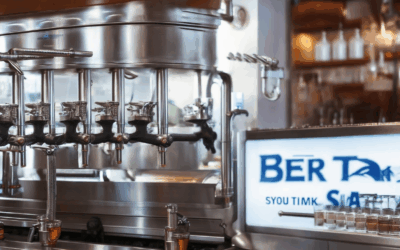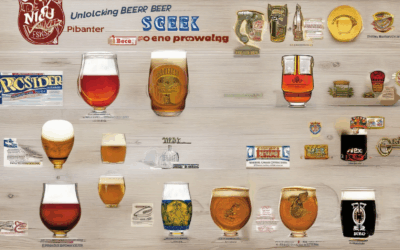Beer has long been a cornerstone of human culture, tracing back thousands of years to ancient civilizations where its production and enjoyment became integral to social life. The study of beer, often referred to as beer research, delves into the science, history, and industry behind this beloved beverage. From understanding fermentation processes to exploring the impact of brewing techniques on flavor profiles, beer research encompasses a wide range of disciplines, including chemistry, microbiology, and even archaeology. At the forefront of this exploration is the Beer Research Institute, a leading authority dedicated to advancing knowledge through innovative studies and collaborations with brewers worldwide. Whether you’re curious about the latest developments in craft beer production or eager to uncover the fascinating history of beer, this article offers a comprehensive look at the science and industry shaping the world of hops. Join us as we unlock the hops and dive into the fascinating world of beer research, where tradition meets innovation and every pour tells a story.

The Study of Beer
The study of beer encompasses a broad range of disciplines, collectively referred to as beerology or zythology. These fields explore the history, production, chemistry, and cultural significance of beer.
Beerology
Beerology delves into the historical and artistic aspects of brewing. It examines the evolution of beer through civilizations, the development of different beer styles, and the role of beer in cultural traditions. This field also touches on the craftsmanship involved in brewing, including the use of malt, hops, and yeast.
Zythology
Zythology is a more specialized branch that focuses on the scientific aspects of beer production. It investigates the chemical reactions during fermentation, the impact of different ingredients on flavor, and the brewing process itself. This field often overlaps with food science and microbiology, allowing brewers to innovate and improve the quality of their products.
Applications and Impact
The study of beer has practical applications in brewing, food science, and even agriculture. Brewers can use insights from these fields to develop new recipes and improve efficiency. Additionally, the study of beer contributes to our understanding of microbiology and the role of yeast in fermentation processes.
Future Trends
As technology advances, the study of beer continues to evolve. Innovations in genetic engineering may lead to new types of yeast, while automation could transform traditional brewing methods. These changes are likely to spawn new areas of study focused on sustainability and the environmental impact of beer production.
Educational Resources
For those interested in learning more about beer, there are numerous resources available. Universities offering courses in beer studies, such as those at the University of California Davis, provide comprehensive education on brewing and its related sciences. Libraries and archives specializing in culinary and beverage studies also offer valuable materials.
Cultural Significance
Beyond its scientific aspects, beer holds significant cultural importance. The study of beer reveals the traditions and practices of different regions, from ancient brewing techniques to modern craft beer movements. This cultural exploration highlights the social and economic roles of beer throughout history.
Conclusion
The study of beer, whether approached through beerology or zythology, offers a rich and complex understanding of this ancient beverage. By combining historical, artistic, and scientific perspectives, this field continues to shape our appreciation and production of beer today.
The Biggest Problem for the Beer Industry
The beer industry faces several significant challenges, with the most prominent issue being intense competition and market saturation. With the rise of craft breweries and established players expanding their portfolios, the market has become increasingly crowded. This competition drives prices down and makes it difficult for smaller breweries to differentiate themselves.
Another major challenge is supply chain disruptions. The industry relies heavily on stable ingredient and packaging supplies, which can be disrupted by factors like raw material shortages, transportation delays, or logistical bottlenecks. This instability affects production schedules and inventory levels, leading to potential shortages or increased costs.
Additionally, regulatory challenges pose a significant barrier. Changes in tax policies, alcohol regulations, and distribution laws can vary by region, requiring breweries to navigate complex compliance requirements. This adds operational complexity and financial uncertainty for businesses.
Sustainability concerns also loom large. The beer industry has a substantial environmental footprint due to packaging, water usage, and energy consumption. Meeting growing consumer demand for eco-friendly products requires investments in sustainable practices, which can strain profit margins.
Finally, evolving consumer preferences present ongoing challenges. Consumers are seeking out more diverse options, including organic, gluten-free, and vegan beers. Failing to meet these demands can alienate certain segments of the market and hinder growth.
These factors collectively create a dynamic and challenging landscape for the beer industry, necessitating innovation, adaptability, and strategic planning to remain competitive.

What is the new study about beer?
The recent study conducted by researchers at the University of California, Davis, has revealed interesting insights into the dietary habits and lifestyle choices of beer drinkers compared to those who prefer wine. The study, published in the Journal of Nutrition, found that beer drinkers may have less healthy lifestyles overall.
- Beer drinkers are more likely to smoke cigarettes and have lower incomes compared to wine drinkers.
- They tend to consume more calories daily, often due to the higher alcohol content in beer compared to wine.
- Physical activity levels among beer drinkers are significantly lower than those who opt for wine.
- Younger individuals and males are more likely to prefer beer over wine.
The study suggests that beer’s higher calorie content and association with certain lifestyle factors may contribute to these findings. However, it’s important to note that moderate alcohol consumption, regardless of the type, can still be part of a balanced diet when combined with a healthy lifestyle.
For more information on beer trends and dietary considerations, visit The Goods On Tap , your trusted source for craft beer insights and resources.
Additionally, consult a healthcare professional before making significant changes to your diet or lifestyle based on this study’s findings.

Science Facts About Beer
Beer is one of the oldest and most widely consumed alcoholic beverages in the world, with a rich history tied to human culture. Here are some fascinating science facts about beer:
- Ingredients: Beer is primarily made from malted barley, hops, yeast, and water. Malted barley provides the starches needed for fermentation, while hops add bitterness and act as a preservative.
- The Malting Process: Malting transforms raw barley into malt by allowing it to germinate and then kilning it to stop the growth. This process converts starches into sugars, which are essential for fermentation.
- Fermentation: Yeast plays a crucial role in turning sugar into alcohol. During fermentation, yeast consumes the sugars, producing ethanol and carbon dioxide, which gives beer its fizz.
- Hops: Hops are added during the brewing process to balance the sweetness of the malt with bitterness. Different hop varieties contribute unique flavors and aromas to beer.
- Flavor Science: The flavor profile of beer is influenced by the type of yeast used, fermentation temperature, and the presence of esters produced during fermentation.
- Alcohol Content: The alcohol byvolume (ABV) of beer varies widely, ranging from less than 5% ABV for light beers to over 30% ABV for strong ales and stouts.
- Health Benefits: Moderate consumption of beer may offer health benefits, including improved heart health and cognitive function, thanks to compounds like antioxidants found in hops and barley.
- Sustainability: Many breweries are adopting eco-friendly practices, such as using renewable energy, reducing water usage, and recycling packaging materials.
Learn more about the craft beer industry and explore detailed brewery reviews, beer trends, and brewing techniques by visiting our comprehensive guide at The Goods On Tap .
Fun Fact About Beer
- Beer is one of the oldest beverages known to humanity, with evidence of its production dating back over 10,000 years.
- Spontaneous fermentation, where yeast naturally ferments the sugars in beer, was discovered accidentally by ancient brewers who noticed that uncovered barrels of beer developed a tangy flavor due to wild yeast.
- Craft beer has exploded in popularity in recent decades, with over 100 distinct styles available globally, catering to every taste preference.
- Hops, a key ingredient in beer, were originally discovered by a Belgian monk in the 13th century when he dropped some into a brew, accidentally creating a new flavor profile that became the basis for modern beer.
- Beer has been used as a form of payment in many cultures throughout history, often more reliable than currency itself in some regions.
- Modern beer production includes a process called pasteurization, which kills bacteria and preserves the beer longer, allowing it to be shipped over long distances without spoiling.
- Beer also contains small amounts of vitamin B and fiber, contributing to its potential health benefits, though moderation is advised due to its alcohol content.
- The foamy head on top of beer is called “beer foam” or “head,” created by the interaction of proteins and carbonation in the beer.

Which Country Drinks the Most Beer?
The title of the country that drinks the most beer can be debated, but according to recent global alcohol consumption reports, several nations stand out due to their high beer drinking habits. Here’s a breakdown of the top contenders:
- Germany : Known for its rich beer culture, Germany leads the pack with annual per capita consumption of over 40 liters. Oktoberfest, one of the largest beer festivals globally, significantly boosts this figure.
- Brazil : With a vibrant nightlife and social scene, Brazil consumes approximately 30 liters of beer per capita annually. Beer is a popular choice during barbecues and celebrations.
- United States : The U.S. is a major beer-drinking nation, with annual per capita consumption around 25 liters. The craft beer movement has further fueled this demand.
- Russia : Russia also ranks high, with heavy consumption influenced by cold weather and a tradition of sharing vodka and beer during gatherings. Exact figures often vary, but it’s a notable contender.
These rankings highlight the cultural significance and economic factors driving beer consumption in each region. Factors such as climate, festival traditions, and accessibility play a crucial role in shaping these statistics.
Conclusion
While Germany consistently tops the list, countries like Brazil, the U.S., and Russia are close behind, showcasing diverse beer cultures and consumption patterns across the globe.




0 Comments